“LIFE IS BUT A DREAM” (1894)
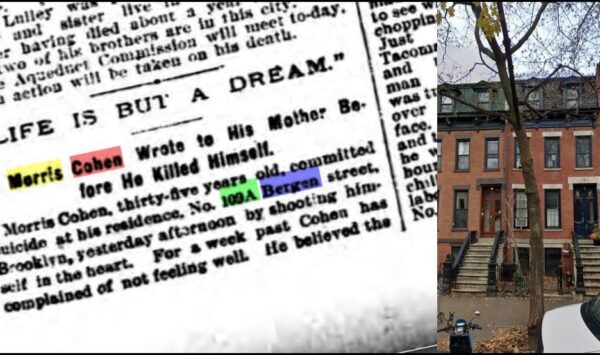
******************************************************************************************************************************** Brownstone Detectives investigates the history of our clients’ homes. The story you are about to read was composed from research conducted in the course of one of those investigations. Do you know the history of YOUR house? ******************************************************************************************************************************** (From The New York Herald, Wed., 7 March 1894.) “LIFE IS BUT A DREAM.” So wrote Morris Cohen to his mother before he killed himself. Morris Cohen, thirty-five years old, committed suicide at his residence, No. 109A Bergen street, Brooklyn, yesterday afternoon by shooting himself in the heart. For a weak past, Cohen has complained of not feeling well. He believed the grip had attacked him. At noon yesterday he returned to his home from his place of business, No. 143 Smith street. He was met at the door by his mother, to who he said that he was going to his room to lie down. He asked her to call him at two o’clocl. At that house his mother went to his room and foudn him on the bed. In his right hand, tightly clutched, was a .38 calibre revolver. His clothing was covered with blood. The suicide had sent but one bullet into his body and this, from all appearances, had caused instant death. On the dressing case in the room was a letter written by Cohen to his mother as follows: “Life is but a dream.” My dream is o’er. I am going crazy to lie in a silent tomb. Dear mother, don’t shed a tear or wear […]
RESCUE OPERATION ON “BOERUM HILL” (1964)
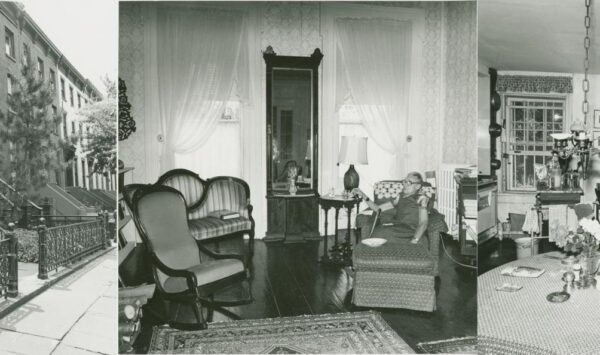
******************************************************************************************************************************** Brownstone Detectives investigates the history of our clients’ homes. The story you are about to read was composed from research conducted in the course of one of those investigations. Do you know the history of YOUR house? ******************************************************************************************************************************** Most Boerum Hill residents do not know the name Helen Buckler – but they should. While she wasn’t instrumental in building Boerum Hill, she was the reason it got its name. She also started the organization that ushered in the wave of brownstoners and brownstoning in the area, the Boerum Hill Association. Brownstoning – or the renovation of brownstones back to their former glory – is not a recent trend. Like many other movements, brownstoning appeared in parts of New York City in waves as good/bad economic times ebbed and flowed, neighborhoods fell in and out of fashion, and young professionals, who were usually the harbingers of those waves, “discovered” New York City’s 19th century brownstones. One of those waves washed over Brooklyn in the early 1960s. Helen Buckler rode, from her Dean Street brownstone, firmly atop the crest of that era’s wave. She named it Boerum Hill. BOERUM HILL BEGINS A few years after Buckler bought No. 238 Dean Street, she started the Boerum Hill Association. Then, already at the age of 70, she was no ordinary brownstoner. Her enthusiasm attracted to the organization approximately 20 like-minded families who were also interested in renovating their brownstones in the area. The purpose of the organization was to improve the community and […]
THE PEDIGREE OF “BOERUM’S HILL” (1776)
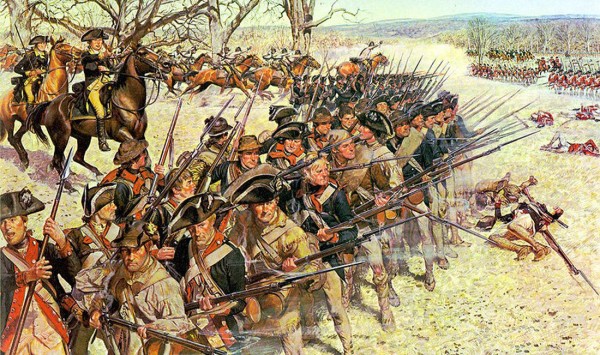
******************************************************************************************************************************** Brownstone Detectives investigates the history of our clients’ homes. The story you are about to read was composed from research conducted in the course of one of those investigations. Do you know the history of YOUR house? ******************************************************************************************************************************** What must it be like to have your identity co-opted for the purposes of obtaining personal credit? Though we cannot ask this question of Farmer Boerum – he’s been dead for more than 200 years – we can guess at what the old Dutch farmer would say. The name, Boerum Hill, which was commandeered from the colonial farm owned by the Boerum Family, in point of fact had its origination with an actual hill that existed on his farm – located in today’s Carroll Gardens/Gowanus – that was then locally known as “Boerum’s Hill” (then “Fort Boerum” during the Revolutionary War). Confused? Sure. Sooooooo…it’s a little like saying, “I named my dog ‘Spot’s Wart’ – after the wart on my dog, Spot.” OK. Well….maybe not exactly. But close. WHAT WAS BOERUM’S HILL? Boerum’s Hill, first and foremost was a natural topographical feature – an elevation or rise – on the Boerum Farm. We know little of its geographic specifications (height, width, slope, &c.) other than that. Located in today’s Gowanus/Carroll Gardens area, it was, additionally, a strategic military position known, during the Battle of Brooklyn, as Fort Box (and later, during the War of 1812, as Fort Fireman). So, we have a good indication, at least, that the hill was of […]
THE BOERUM HILL SNAKE-OIL MAN (1885)
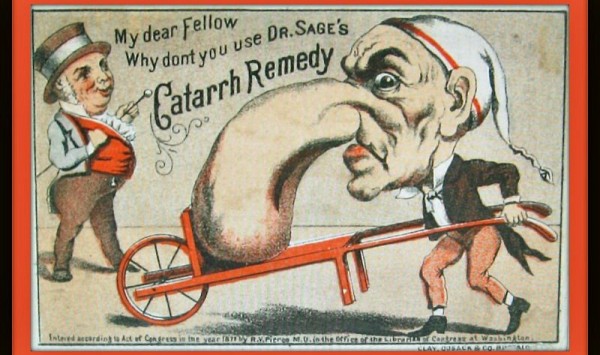
******************************************************************************************************************************** Brownstone Detectives investigates the history of our clients’ homes. The story you are about to read was composed from research conducted in the course of one of those investigations. Do you know the history of YOUR house? ******************************************************************************************************************************** If you climbed to the third floor of 375 Pacific Street in 1885, two floors above its stable, and you passed through “several mysterious little doors,” you might find “a little room where seven girls were busily engaged” in filling and labeling numerous clear bottles. And if you thought, while climbing the thin stairway and passing through the oddly small doors, that perhaps you were entering upon the quarters of a crime syndicate or those of a mafia den, you would not have been too very far from the truth. MAKING, BOTTLING, AND SELLING THE CURE Years before the Pure Food and Drug Act was signed into law in 1906, patent medicine salesmen were plying the U.S. mails with great success. Although their “cures” brought their clients considerably less success, their hopes were still strong and snake oil continued to sell at a good clip. Patent medicine salesmen were everywhere, advertising everywhere, and came from a number of professions – failed doctors, teachers, tinsmiths, and even wood engravers. What a wood engraver might have known about medicine was probably never in dispute – all he needed to know was how to sell a product – what was in dispute was the fact that his “cure” did nothing other than make the […]
A STREET GROWS IN BROOKLYN (1845)
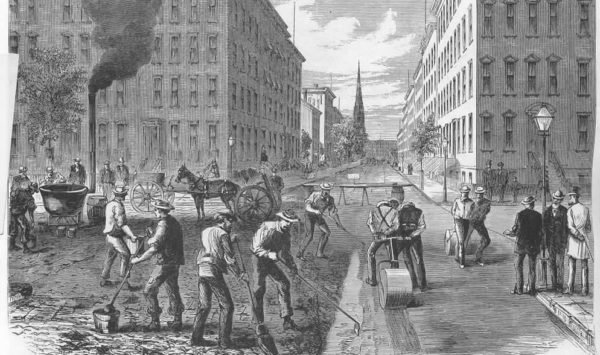
******************************************************************************************************************************** Brownstone Detectives investigates the history of our clients’ homes. The story you are about to read was composed from research conducted in the course of one of those investigations. Do you know the history of YOUR house? ******************************************************************************************************************************** The growth of brownstone Brooklyn took place over a great many years. The long contiguous lines of rowhouses rocketed skywards across the city through the economic good times, as well as – at a less robust pace – through the many debilitating recessions. But rocket they did, leaving the footprints of the many contractors and builders who changed the landscape of Brooklyn into a City of Houses. Another mark that the contractors and builders left – although one not as celebrated today – was the complicated system of flagging, pipes, sewers, cisterns, streetlamps, and sometimes trolley tracks, that lined the streets and led to those very rowhouses. Each delivery and receiving system that connected each rowhouse to the city was an important step toward the development of the city. Before each row of houses was constructed (and sometimes while they were being constructed, or even soon afterwards), the development of each street and neighborhood was an important part of attracting the homeowners to Brooklyn. THE BIRTH OF BOERUM HILL Boerum Hill had only recently been planned for with a street grid system that would develop alongside of a vast network of sidewalks, sewers, street lamps, gas lines, and water mains. At this time, however, in the 1840s, it barely resembled such […]
BOERUM HILL TIMEWARP! (1922 vs. 2018)
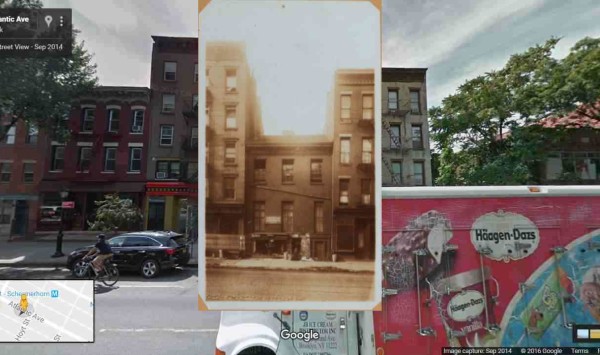
******************************************************************************************************************************** Brownstone Detectives investigates the history of our clients’ homes. The story you are about to read was composed from research conducted in the course of one of those investigations. Do you know the history of YOUR house? ******************************************************************************************************************************** It’s always a blast to compare old photographs of Brooklyn streets with what is there now. Often the old buildings, street lamps, and flagstone sidewalks are long gone, but sometimes you are discover a treat that makes the journey worthwhile. With a little help from the internet it’s easy to make these comparisons and then to even bring the past back to life. Using the Old NYC app, which allows you to search a map of the city to find locations where old New York City pictures were taken (and are stored at the New York Public Library’s Digital Collections), you can search for any address within the five boroughs. With some luck you might find an actual picture of the building or location you are looking for. With our case, we were looking for street addresses on Atlantic Avenue. Searching the database, we found 336 Atlantic Avenue. The picture was described as “336 Atlantic Ave., south side, west of Hoyt Street,” and this particular photograph had a little more information than you usually get on this site – information on the building’s conveyance from one owner to the next, likely around 1922. The caption at the library’s site further notes that the photograph showed “a home bought by Mrs. Pruize […]
“MORALS OF MINNIE” ON GARFIELD PL. (1912)
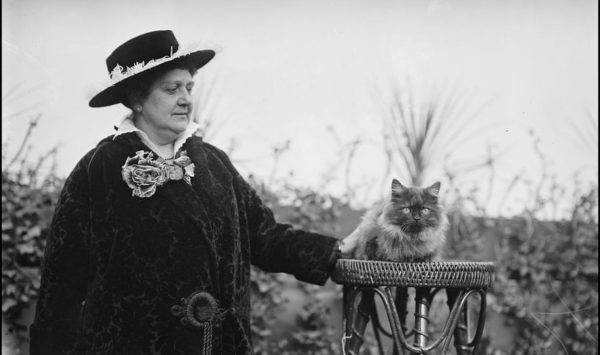
******************************************************************************************************************************** Brownstone Detectives investigates the history of our clients’ homes. The story you are about to read was composed from research conducted in the course of one of those investigations. Do you know the history of YOUR house? ******************************************************************************************************************************** In 1912, a Park Slope cat named Minnie found herself in some hot water. According to a complaint, Minnie’s claws had allegedly performed some serious mutilation to a neighbor’s roof. Here, now, are the details of: THE CURIOUS CASE OF THE CAT THAT CLAWED Location – Garfield Place (between 6th and 7th avenues). Suspect’s address – No. 182 Garfield Place, the Inasmuch Home for Aged Women. Claimant’s address – No. 178 Garfield Place, home of one William Albert Robbins, attorney. Suspect – one “Minnie,” a white Persian, and allegedly “immoral,” cat. THE WANDERINGS OF THE “INASMUCH” Around 1909, the Inasmuch Home for Aged Women moved from its previous location on Bergen Street to its new home at No. 182 Garfield Place in Park Slope between 6th and 7th Avenues. The Inasmuch (sometimes referred to as the “In-As-Much” by sloppy journalists) was a “charity” home for “aged women who are unable to get into other homes,” run through contributions and donations. It was founded in 1905, a few years before the move to Garfield Place. At that time, it existed in the Gowanus at No. 390 Douglass Street, and later moved to (what would become) the Boerum Hill section at No. 226 Bergen Street. By 1920, when it was finally closed, the […]
THE FIREMEN OF DOWNTOWN BROOKLYN (1905)
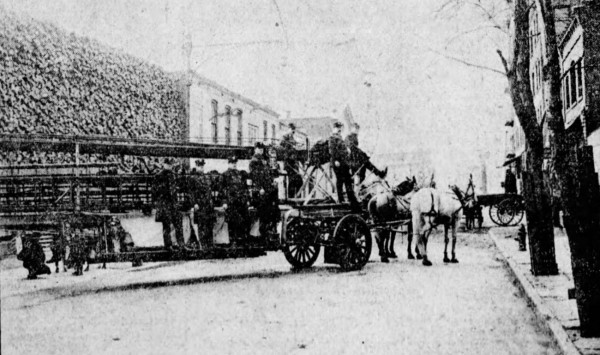
******************************************************************************************************************************** Brownstone Detectives investigates the history of our clients’ homes. The story you are about to read was composed from research conducted in the course of one of those investigations. Do you know the history of YOUR house? ******************************************************************************************************************************** “A Day With the Fire Fighters from Brooklyn” was a newspaper feature spread from 1905. The spread seems to have followed Truck 60, which was located at State and Smith Streets in what was, at the time, known as Downtown Brooklyn, and is now named Boerum Hill . Follow @BrownstoneDetec Share ———————————————————————————————————————– The Brownstone Detectives Brownstone Detectives is an historic property research agency. Our mission is to document and save the histories of our clients’ homes. From our research, we produce our celebrated House History Books and House History Reports. Contact us today to begin discovering the history of your home.